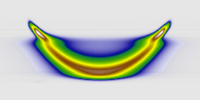Nonequilibrium physics study published in Physical Review X
Posted in News Story
 Professor Freericks is part of a team that published a study on how metals relax after an intense laser is shone on them. The paper is published in the new on-line journal Physical Review X.
Professor Freericks is part of a team that published a study on how metals relax after an intense laser is shone on them. The paper is published in the new on-line journal Physical Review X.
The popular summary of the article follows:
Electrons in a solid-state material remain in their preferred state, the so-called equilibrium state, if left undisturbed. Taking them out of this equilibrium state by a short laser pulse and “watching” how they relax back to their equilibrium with a second pulse is analogous to making a movie of electronic dynamics in situ. This type of pump-probe laser spectroscopy, so far largely limited to the field of atomic and molecular physics, is gaining a surging interest in condensed matter physics. One of its potentials is as a method for probing the so-called electron-phonon coupling—the dynamics of interaction between electrons and quantum modes of collective vibrations of the atomic nuclei in a solid-state material, crucial to the understanding of, for example, superconductivity among many phenomena. But, how to make sense of the “movies” obtained in this way remains a fundamental challenge. In this theoretical paper, we make a significant step in the development of a concrete and general understanding of pump-probe spectroscopy studies of electron-phonon coupling.
Our understanding comes from an in-depth study of a model system of electron-phonon coupling driven by an ultrashort laser pulse. Through the study, we show that the frequency of the phonons determines a window of electronic energy in which the electrons relax more slowly than when their energy is outside the window. By analyzing the energy-dependent electronic relaxation time, we can directly determine the strength of electron-phonon coupling—without the need to resort to any assumptions for electronic distribution in terms of electronic temperature and underlying bare-band structure, which is required by the existing methods for determining electron-phonon coupling.
The potential impact on future work lies in shaping a new language for ultrafast processes and in the prospect of a quantitative comparison between ultrafast experiments and theory as well as a new way of understanding and analyzing data beyond the traditional effective electronic-temperature models.
